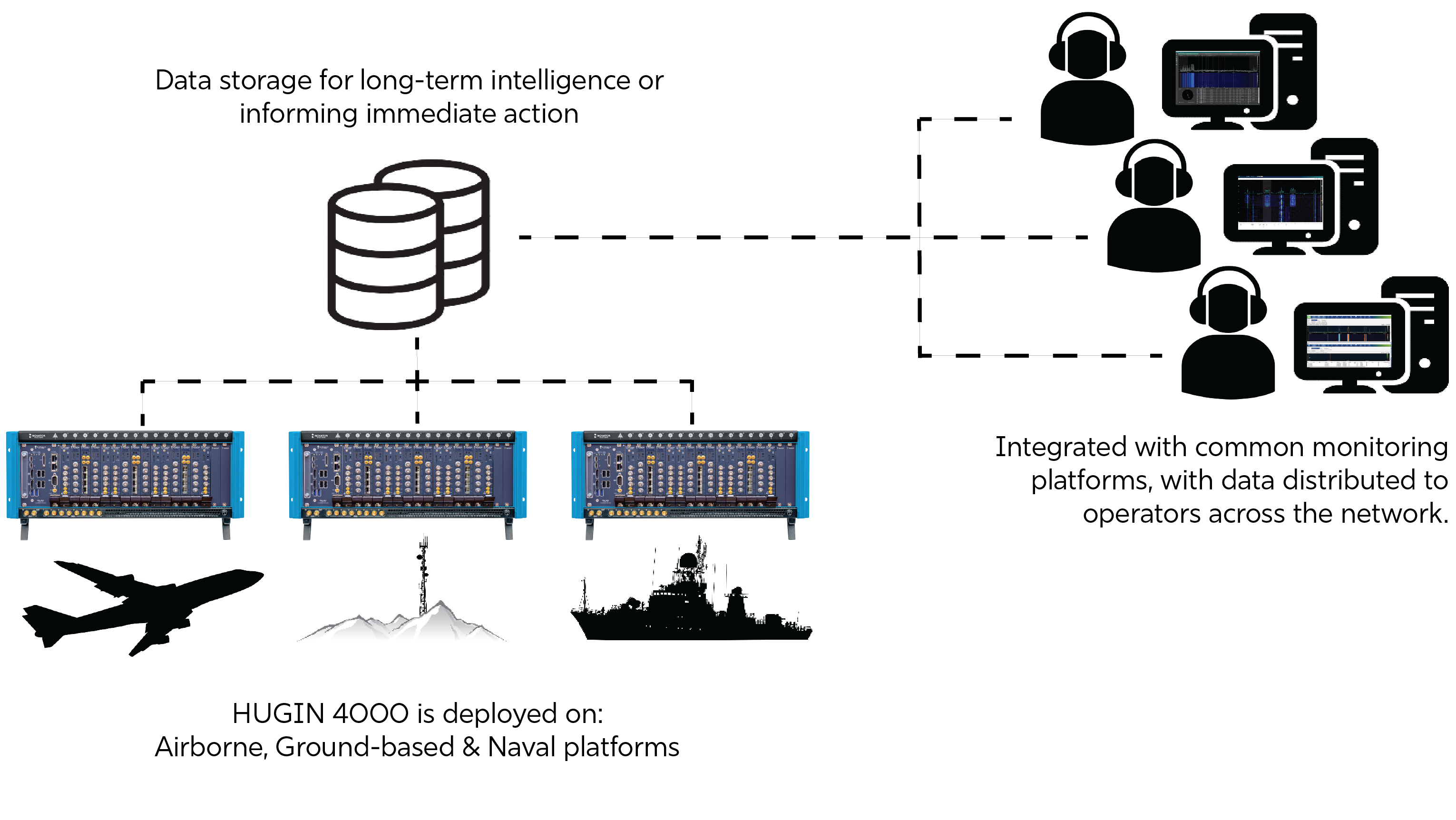Integrering av sensorer för kommunikationsunderrättelse med avancerade processystem
Integrering av COMINT-sensorer
COMINT-sensorer (Communications Intelligence) med radiofrekvenser (RF) spelar en viktig roll i modern elektronisk krigföring, underrättelseinhämtning och övervakning. Sensorer som Novator Solutions HUGIN 4000 fångar upp, analyserar och bearbetar RF-signaler för att utvinna värdefull information.
Genom att integrera COMINT-sensorer med analytiska och bearbetande delsystem ökar deras effektivitet, vilket möjliggör förbättrad signaldetektering, klassificering och utnyttjande. I den här artikeln beskrivs hur ett COMINT-system kan integreras med riktningsgivande nätverk, röstinspelning, mänsklig språkteknologi, I/Q-inspelning och digital demodulering.

Analog demodulering i realtid och integrering med digital demodulering
Data i kommunikationssignaler kan utgöras av analog eller digital modulering som läggs till bärfrekvensen. COMINT-system måste kunna demodulera och extrahera dessa data från de avlyssnade RF-signalerna.
HUGIN 4000 har inbyggd realtidsdemodulering för analoga signaler - med specifikt stöd för AM, FM, LSB och USB - i systemets inbyggda FPGA:er. Denna kapacitet används vanligtvis för att avlyssna signaler i okrypterade analoga sändningar, t.ex. från komradio. För digital demodulering kan HUGIN 4000 strömma rå IQ-data (i fas och kvadratur) till bearbetningsprogram på en värd- eller server-PC.
Digitala demodulatorer bearbetar signaler som modulerats i system som QPSK, QAM och OFDM, vilket gör dem särskilt användbara för avlyssning av till exempel TETRA-, P-25- eller DMR-system (digital mobilradio). Genom att extrahera strukturerad data från avlyssnade signaler kan analytiker hämta meddelanden, metadata eller kontrollinformation. Dessa förmågor gör att COMINT-sensorer effektivt kan demodulera modern digital kommunikation som används i militära, kommersiella och hemliga sändningar.
Integration med nätverk för riktningsbestämning (DF)
Riktningsbestämning (DF) är avgörande för att lokalisera signalkällor och spåra mål. HUGIN 4000 kan integreras med DF-nätverk med hjälp av metoder som t.ex: TDOA (Time Difference of Arrival), som mäter tidsfördröjningen mellan signalens ankomst till olika sensorer för att triangulera källan; och AOA (Angle of Arrival), där en grupp riktantenner bestämmer en signals inkommande vinkel.
Faskoherens mellan ingångarna är avgörande för att uppnå en korrekt uppskattning av ankomstvinkeln, och därför tillåter HUGIN 4000 delning av lokala oscillatorer mellan RF-ingångarna. HUGIN 4000 kan också innehålla en förbättrad tidsmodul för IRIG-B eller GPS, för ännu mer exakt tidsstämpling av avlyssning. Således kan ankomsttiden jämföras mellan flera rumsligt distribuerade HUGIN 4000-sensorer för att utföra TDOA.
Integrering av spektrumövervakning med pejlingsfunktioner ger förbättrad situationsmedvetenhet och möjliggör positionsspårning i realtid av sändare för militära, brottsbekämpande och säkerhetsmässiga tillämpningar.
Integration med I/Q-inspelning för signalforskning och utveckling av motmedel
I/Q-data representerar den råa, obearbetade RF-signalen och är avgörande för djupgående signalanalys och ombearbetning. I/Q-datafångst med hög kvalitet gör det möjligt för analytiker att undersöka signaler mer i detalj, tillämpa maskininlärningsalgoritmer för signalklassificering och återbesöka historiska signaler för vidare undersökning. Den här förmågan är ovärderlig för att förstå komplexa signalstrukturer och utveckla motåtgärder mot nya hot.
Tekniker för extrahering av funktioner hjälper till att identifiera modulationstyper, variationer i signalstyrka och bandbreddsegenskaper. Automatiserad klassificering med hjälp av artificiell intelligens känner igen kända och okända signaler, medan hotbedömning utvärderar uppsnappade signaler för underrättelsebetydelse. Genom att korrelera signaler med befintliga databaser kan man upptäcka mönster och spåra motståndarnas kommunikationstekniker, vilket gör att underrättelseteamen kan ligga steget före nya hot.
HUGIN 4000 gör det möjligt att strömma komplexa 64-bitars I/Q-data för inspelning och efterbehandling, med möjlighet till VITA 49-överensstämmelse för interoperabilitet med vanliga signalbehandlingsplattformar.
Integration med röstinspelning och Human Language Technology (HLT)
För underrättelseverksamhet är inspelning och lagring av röstkommunikation som fångas upp av COMINT-sensorer av avgörande betydelse. Processen omfattar utvinning av röstdata genom demodulering av analoga eller digitala sändningar, lagring och indexering av inspelningar för framtida hämtning och analys samt synkronisering av röstinspelningar med metadata såsom geolokalisering och signalegenskaper. Dessa funktioner gör det möjligt för analytiker att granska avlyssnade samtal, upptäcka mönster och identifiera talare, vilket avsevärt förbättrar underrättelseinhämtningen.
Human Language Technology (HLT) förbättrar möjligheten att bearbeta och analysera röstkommunikation som fångas upp av RF-sensorer. Automatic Speech Recognition (ASR) omvandlar röst till text, vilket gör det lättare att söka efter nyckelord. Talaridentifiering katalogiserar olika röster baserat på deras unika egenskaper, medan språkidentifiering och översättning möjliggör realtidsförståelse av kommunikation på främmande språk. Dessutom kan nyckelordsspaning och känsloanalys hjälpa till att identifiera kritiska fraser, hot eller känslomässiga toner. Dessa integrationer förbättrar hastigheten och noggrannheten i underrättelseanalysen.
Slutsats
Genom att integrera COMINT-sensorer som HUGIN 4000 med digitala demodulatorer, pejlnätverk, mänsklig språkteknologi och I/Q-inspelning förbättras förmågan till underrättelseinhämtning avsevärt. Kombinationen av dessa tekniker möjliggör situationsmedvetenhet i realtid, djupgående signalanalys och automatiserad bearbetning. I takt med att nya hot dyker upp och kommunikationsmetoderna utvecklas är det avgörande att COMINT-sensorerna är kompatibla med den senaste tekniken för bearbetning.
För mer information om den tekniska implementeringen av att integrera HUGIN 4000 med delsystem via ett TCP/IP API, vänligen läs applikationsmeddelandet "Integrering av HUGIN-servrar".
